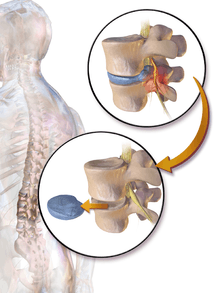Discectomy
| Discectomy | |
|---|---|
| Intervention | |
 Median sagittal section of two lumbar vertebrae and their ligaments. ("Intervertebral fibrocartilage", an old name for the intervertebral disc, labeled at center left.) | |
| ICD-9-CM | 80.51 |
| MeSH | D017586 |
| MedlinePlus | 007250 |

A discectomy (also called open discectomy) is the surgical removal of herniated disc material that presses on a nerve root or the spinal cord. The procedure involves removing the central portion of an intervertebral disc, the nucleus pulposus, which causes pain by stressing the spinal cord or radiating nerves. The traditional open discectomy, or Love's technique, was published by Ross and Love in 1971. Advances in options have produced effective alternatives to traditional discectomy procedures (e.g. microdiscectomy, endoscopic discectomy, and laser discectomy). In conjunction with the traditional discectomy, a laminotomy is often involved to permit access to the intervertebral disc. In this procedure, a small piece of bone (the lamina) is removed from the affected vertebra, allowing the surgeon to better see and access the area of disc herniation.
In the U.S., it has been estimated that the Medicare system spends over $300 million annually on lumbar discectomies.[1]
Microdiscectomy
Microdiscectomy is a minimally invasive surgical procedure in which a portion of a herniated nucleus pulpolsus is removed by way of a surgical instrument or laser while using an operating microscope or loupe for magnification.[2]
See also
- Back pain
- Anterior cervical discectomy and fusion
- Lumbar disc herniation
- Degenerative disc disease
- Failed back surgery
- Percutaneous discectomy
- List of surgeries by type
References
- ↑ Schoenfeld, A. J.; Weiner, B. K. (2010). "Treatment of lumbar disc herniation: Evidence-based practice". International Journal of General Medicine. 3: 209–214. PMC 2915533
 . PMID 20689695.
. PMID 20689695. - ↑ "Back and Leg Pain - Definition List | Resources | HJD Spine Center". Med.nyu.edu. Retrieved 2010-12-18.
- Emmett, J. L.; Love, J. G. (1971). "Vesical dysfunction caused by protruded lumbar disk". The Journal of urology. 105 (1): 86–91. PMID 5100876.
External links
{{Operations and other procedures on the
musculoskeletal system}}